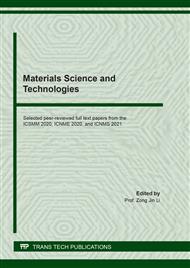[1]
A. K. Parida, R. Das, A. Sahoo, and B. Routara. Optimization of cutting parameters for surface roughness in machining of GFRP composites with graphite/fly ash filler. in Procedia Materials Science. (2014).
DOI: 10.1016/j.mspro.2014.07.134
Google Scholar
[2]
S. Sharma, S. Tamang, D. Devarasiddappa, and M. Chandrasekran. Fuzzy logic modeling and multiple performance optimization in turning GFRP composites using desirability function analysis. in Procedia materials science. (2014).
DOI: 10.1016/j.mspro.2014.07.211
Google Scholar
[3]
J. P. Davim and F. Mata: The International Journal of Advanced Manufacturing Technology.Vol. 26 (2005), pp.319-323.
Google Scholar
[4]
G. Santhanakrishnan, R. Krishnamurthy, and S. Malhotra: Journal of Mechanical Working Technology.Vol. 17 (1988), pp.195-204.
Google Scholar
[5]
K. Sakuma and M. Seto: Bulletin of JSME.Vol. 26 (1983), pp.1420-1427.
Google Scholar
[6]
J. Zhou, H. Walter, M. Andersson, and J. Stahl: International Journal of Machine Tools and Manufacture.Vol. 43 (2003), pp.301-305.
Google Scholar
[7]
N. Dhar, M. Kamruzzaman, and M. Ahmed: Journal of materials processing technology.Vol. 172 (2006), pp.299-304.
Google Scholar
[8]
I. Karadzic, A. Masui, and N. Fujiwara: Journal of bioscience and bioengineering.Vol. 98 (2004), pp.145-152.
Google Scholar
[9]
M. N. Sharif, S. Pervaiz, and I. Deiab: The International Journal of Advanced Manufacturing Technology.Vol. 89 (2017), pp.2447-2479.
Google Scholar
[10]
J. Sutherland, V. Kulur, N. King, and B. Von Turkovich: CIRP Annals.Vol. 49 (2000), pp.61-64.
DOI: 10.1016/s0007-8506(07)62896-0
Google Scholar
[11]
K. D. Timmerhaus and R. P. Reed: Cryogenic engineering: fifty years of progress. Springer Science & Business Media. (2007).
Google Scholar
[12]
T. Stefánsson: Application of Cryogenic Coolants in Machining Processes: State-of-the-art Literature Study and Experimental Work on Metal Matrix Composite. (2014).
Google Scholar
[13]
S. Debnath, M. M. Reddy, and Q. S. Yi: Journal of cleaner production.Vol. 83 (2014), pp.33-47.
Google Scholar
[14]
C. Veiga, J. Davim, and A. Loureiro: Rev. Adv. Mater. Sci.Vol. 34 (2013), pp.148-164.
Google Scholar
[15]
S. Y. Hong and Y. Ding: International Journal of Machine Tools and Manufacture.Vol. 41 (2001), pp.1417-1437.
Google Scholar
[16]
M. Bermingham, J. Kirsch, S. Sun, S. Palanisamy, and M. Dargusch: International Journal of Machine Tools and Manufacture.Vol. 51 (2011), pp.500-511.
DOI: 10.1016/j.ijmachtools.2011.02.009
Google Scholar
[17]
S. S. Gill, J. Singh, H. Singh, and R. Singh: International Journal of Machine Tools and Manufacture.Vol. 51 (2011), pp.25-33.
Google Scholar
[18]
W. E. Bryson: Cryogenics. Hanser Gardner Publications. pp.81-107.(1999).
Google Scholar
[19]
S. A. Hussain, V. Pandurangadu, and K. Palanikumar: European journal of scientific research.Vol. 41 (2010), pp.84-98.
Google Scholar
[20]
M. A. Khan, A. S. Kumar, S. T. Kumaran, M. Uthayakumar, and T. J. Ko: Silicon.Vol. 11 (2019), pp.153-158.
Google Scholar
[21]
H. F. Mark: Encyclopedia of polymer science and technology, concise. John Wiley & Sons.(2013).
Google Scholar
[22]
W. K. Goertzen and M. Kessler: Composites Part B: Engineering.Vol. 38 (2007), pp.1-9.
Google Scholar
[23]
N. Hameed, P. Sreekumar, B. Francis, W. Yang, and S. Thomas: Composites Part A: Applied Science and Manufacturing.Vol. 38 (2007), pp.2422-2432.
DOI: 10.1016/j.compositesa.2007.08.009
Google Scholar
[24]
W. Koenig, C. Wulf, P. Grass, and H. Willerscheid: CIRP Annals.Vol. 34 (1985), pp.537-548.
Google Scholar
[25]
N. S. Kalsi, R. Sehgal, and V. S. Sharma: Bulletin of Materials Science.Vol. 37 (2014), pp.327-335.
Google Scholar
[26]
A. Sert and O. N. Celik: Materials Characterization.Vol. 150 (2019), pp.1-7.
Google Scholar
[27]
P. HV and D. Girish: Journal of Engineering Research and Studies.Vol. 3 (2012), pp.105-107.
Google Scholar


